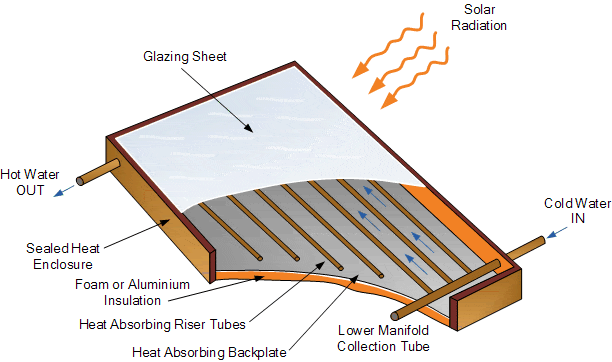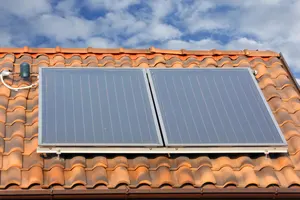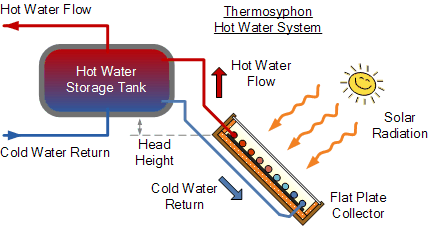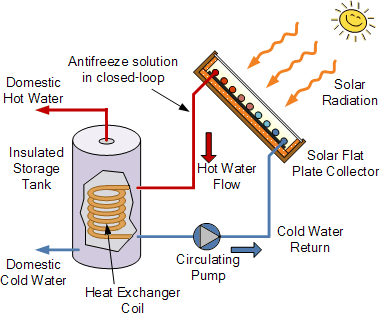
Flat Plate Collector
Solar Flat Plate Collectors for Solar Hot Water
![]() A Flat Plate Collector is a heat exchanger that converts the radiant solar energy from the sun into heat energy using the well known greenhouse effect. It collects, or captures, solar energy and uses that energy to heat water in the home for bathing, washing and heating, and can even be used to heat outdoor swimming pools and hot tubs.
A Flat Plate Collector is a heat exchanger that converts the radiant solar energy from the sun into heat energy using the well known greenhouse effect. It collects, or captures, solar energy and uses that energy to heat water in the home for bathing, washing and heating, and can even be used to heat outdoor swimming pools and hot tubs.
For most residential and small commercial hot water applications, the solar flat plate collector tends to be more cost effective due to their simple design, low cost, and relatively easier installation compared to other forms of hot water heating systems. Also, solar flat plate collectors are more than capable of delivering the necessary quantity of hot water at the required temperature.

A solar flat plate collector typically consists of a large heat absorbing plate, usually a large sheet of copper or aluminium as they are both good conductors of heat, which is painted or chemically etched black to absorb as much solar radiation as possible for maximum efficiency.
This blackened heat absorbing surface has several parallel copper pipes or tubes called risers, running length ways across the plate which contain the heat transfer fluid, typically water.
These copper pipes are bonded, soldered or brazed directly to the absorber plate to ensure maximum surface contact and heat transfer. Sunlight heats the absorbing surface which increases in temperature. As the plate gets hotter this heat is conducted through the risers and absorbed by the fluid flowing inside the copper pipes which is then used by the household.
The pipes and absorber plate are enclosed in an insulated metal or wooden box with a sheet of glazing material, either glass or plastic on the front to protect the enclosed absorber plate and create an insulating air space. This glazing material does not absorb the suns thermal energy to any significant extent and therefore most of the incoming radiation is received by the blackened absorber.
The air gap between the plate and glazing material traps this heat preventing it from escaping back into the atmosphere. As the absorber plate warms up, it transfers heat to the fluid within the collector but it also loses heat to its surroundings. To minimize this loss of heat, the bottom and sides of a flat plate collector are insulated with high temperature rigid foam or aluminium foil insulation as shown.
Typical Flat Plate Collector

Flat plate collectors can heat the fluid inside using either direct or indirect sunlight from a wide range of different angles. They also function in diffused light, which is dominant on cloudy days as it is the surrounding heat that is being absorbed and not the light, unlike photovoltaic cells. How hot the circulating water gets will depend mostly on the time of the year, how clear the skies are and how slowly the water flows through the collectors pipes.
Direct and Indirect Solar Thermal Systems
There are several different ways to heat water for use in the home. Solar water heating systems that use flat plate solar collectors to capture the suns energy can be classed as either direct or indirect systems by the way in which they transfer the heat around the system. In order to heat your water successfully and use it during both the day and the night, you will need to have both a solar collector to capture the heat and transfer it to the water and also a hot water tank to store this hot water for use as needed.
Direct Solar Thermal System
A direct solar water heating system, also known as an active open-loop system, uses a pump to circulate the water around the system. The cooler water is pumped directly from the home to a central water storage or immersion tank and passes through the solar collector for heating. The hot water leaves the flat plate collector and returns back to the tank flowing in a continuous loop. From there, the water is pumped back into the house as hot usable water.
A low voltage 12 volt pump can be used which can be powered by a small photovoltaic cell or electronic controller making the system more green. Direct systems are usually used in warmer climates with few cold days or is drained in winter to stop the water in the pipes from freezing. Chemicals can not be added to the water for protection as the same water that circulates through the flat plate collector is used in the home.
In a passive direct hot water system, the system does not use pumps or control mechanisms to transfer the heat created to the storage tank. Instead, passive systems are what are called “open-loop systems” which use the natural force of gravity to help circulate the water around the system. This type of system uses a solar flat plate collector combined with a horizontally mounted storage tank of some kind located immediately above the collector.
The water heated by the sun rises naturally using convection through the solar collectors pipes and enters the storage tank situated above. As the heated water enters the storage tank above, the cooler water is forced out and flows down to the bottom of the collectors aided by gravity as cold water is more dense than hot water. This cycle of hot water rising and cooler water falling is known as a “thermosyphon flow” and continuously repeats unaided while the sun is shining.
Thermosyphon Hot Water System

The thermosyphon system is the most common type of solar heated hot water system on the market and most commercially available passive direct solar hot water systems use this type of roof-mounted flat plate collector and storage tank combination.
However, care must be taken when installing such a system as the combined weight of the solar collector, storage tank and the water itself my be too much for the design of the supporting roof.
When passive solar hot water systems are used for bigger buildings than for houses, businesses or offices, there is often more than one storage tank for the heated water.
So called remote thermosyphon system works on the same principle as the previous passive direct thermosyphon system, except that the storage tank is located away within the roof space or void dissipating the weight over a larger area and also protecting the storage tank from cold weather and temperatures. However, for the thermosyphoning process to work correctly, the base of the water storage tank must be situated at least 1 to 2 feet (300 to 500mm) above the top of the flat plate collectors. This distance is also known as the systems “head height”.
Indirect Solar Thermal System
An indirect hot water systems, which are also known as closed-loop systems, differs from the previous thermosyphon system in that it uses a heat exchanger which is separate from the solar flat plate collector to heat the water in the storage tank.
Indirect hot water systems are active systems and require pumps to circulate the heat transfer liquid around the closed-loop system from the collector to the heat exchanger in the tank. The system contains an antifreeze solution, typically a 50% Glycol/water mixture, in the primary closed-loop instead of just water which is heated and is kept separate from the main domestic hot water supply.
Indirect Solar Thermal System

The heat exchanger transfers the heat from the collector’s antifreeze solution to the water located in the water storage tank. The heat exchanger can either be a copper coil inside the lower part of the storage tank or a flat plate exchanger outside the storage tank.
One of the main advantages to this closed loop indirect heating system is that the antifreeze solution gives all year round operation in areas where the temperature falls below the freezing point as well as protecting the system from corrosion of the collectors by untreated tap water containing gases and various dissolved salts.
The main advantage of a forced circulation indirect hot water system is that an existing domestic water heating system can easily be converted to solar heating of the water just by adding a flat plate collector and a single pump as most homes use gas or oil fired boilers as well as a hot water storage tank with built-in heat exchanger coil.
The system is also likely to be more efficient, and the hot water storage tank can be placed anywhere in the home because it does not need to be higher than the collectors as in the previous passive or thermosyphon system.
One disadvantage, however, is that the closed-loop system is dependent on electricity for the circulating pump which may be expensive or unreliable. Some designs use a small low voltage pump and photovoltaic panel along side the collector making the system more efficient and greener. For larger installations and in cooler climates the hot-water tanks are included below the roof within buildings, so forced circulation indirect solar water heating is the norm.
Sizing a Solar Flat Plate Collector
Sizing a Solar Flat Plate Collector for use in a solar hot water or heating system depends upon the hot water demand. If the homes hot water consumption or maximum water temperature is reduced, hot water demands may be supplied by a smaller solar array that is easy to install on the roof. Also, smaller thermal systems are cheaper to install and will pay for themselves sooner through energy savings.
Sizing a solar thermal energy system of course depends on your hot water needs, temperature and consumption but general rules of thumb can be used to help give an idea of a system size.
There are all kinds of instructional plans and books available online to help you build your own solar thermal water heater, so why not Click Here and get your copy from Amazon of a set of DIY solar water heater plans and put the sun to work in your home today.
Solar flat plate collectors usually range in size from about 32 square feet (4 x 8 ft) or 3 square metres and can weigh more than 200 pounds or 100 kilo-grams each. One square foot (1000 cm2) heats about two gallons or 10 litres of water per day to well over 70oC. Therefore a single panel of 20 to 30 square feet will heat about 60 gallons (300 litres) of water which is about the size of a standard hot water storage tank.
In general, you will need about 10 to 16 ft2 of flat plate collector area per person and about 1.5 to 2.0 gallons of hot water storage per square foot of collector area. So for a family of four persons this translate into 40 to 60 square feet of collector plate area and 60 to 120 gallons of storage. Then a solar hot water heating system for a family of four would need at least two standard solar flat plate collectors of about 32 square feet (4 x 8 ft) each.
Flat Plate Collector Summary
While Flat Plate Collectors excel at collecting the solar power more effectively, commercially available hot water collectors can sometimes be expensive. Simple and cheaper flat plate panels can be made from old central heating radiators painted black or even a coil of plastic hose or water pipe laid out on top of a roof but the systems efficiency would be very low.
Properly installed domestic solar hot water systems are efficient and reliable. System configurations can from simple thermosyphoning systems that rely on gravity to more complex forced circulation systems that require pumps, controllers, and heat exchangers.
Although they have a higher initial cost than a conventional gas, oil and electric water heaters, solar thermal will dramatically reduce fuel consumption and can have a payback period of less than 10 years. There are several solar water heater design types and plans that are currently manufactured by suppliers. Which water heating systems and designs are suitable for your home or business will largely depend on regional climate.
In the next tutorial about solar heating and solar hot water we will look at another more efficient way of heating water to a much higher temperature using small individual copper collectors vacuum sealed in a glass tube. These types of collectors are commonly known as a Evacuated Tube Collector which are becoming the preferred choice to the Flat Plate Collector.











How hot will the water be coming out of the panel into the home; In Winter, not Summer.Say it’s 20 degrees F outside and a sunny day.
How long is a piece of string? Heat absorption depends on many factors.
Where can I purchase flat plate collectors, and heat exchangers? I want to create some experimental heating for my northern Michigan home. But I don’t know where to find products to buy to help create a system.
If you do not know “where to find products” using Google, then maybe a DIY system is not for you. We are sure there are solar installers in the Michigan area.
Yes we decide buy
hi can i get the refrance that you made the report from ? the book or somthing legal
Hey guys, I have a question, is it applicable to mount the solar panel horizontally, I mean in a way to be the long side of the panel is the one located on the ground. And If it’s applicable, what are the conditions for this way of installing, what precations must be taken into account…
I had this question for a job interview.
Thanks in advance
I’m also waiting patiently for a reply to this question.
in the vertical installation cooler water enters the bottom of the collector and rises collecting heat as it flows to the top through multiple parallel paths. As the water rises through the collector it accumulates more heat. Also consider that heated water will exert its own pressure and add to the pump’s pressure. .Each path is heated equally so that as the water from each path reaches the top of the collector the temperature is fundamentally the same from each path..
In a horizontal installation, the water will not be uniformly heated. the water temperature in the highest parallel path will will increase more the lower parallel paths The horizontal mounting results in a lower efficiency and I would not recommend it.
I would like to use your illustration labeled “typical flat plate collector” in a technical writing course at BYU-Idaho. I would cite the origin of the figure at alternative-energy-tutorials.com. May I have your permission to use this figure? If you charge for permission to use copyrighted material, what would be the charge?
Hello Jennifer and apologies for the delay.
As you have kindly asked, we would have no objection to you using the information and/or images from our website as part of your technical writing course, free of charge.
However, we must ask that you clearly and correctly reference, any images, information, or tutorials taken or copied from our alternative-energy-tutorials.com website accordingly within all of your presentations.
If marking you (alternative-energy-tutorials.com) clearly as the owner, could I use the flat plate collector picture in a university project on solar water heaters?
Hello. As you have kindly asked, we would have no objection to you using the information and/or images of a flat plate collector from our website, free of charge.
However, we must ask that you clearly and correctly reference, any images, information, or tutorials taken or copied from our http://www.alternative-energy-tutorials.com website accordingly within all of your presentations.
Great information about the solar water heating system. Solar water heating is the conversion of sunlight into heat for water heating using a solar thermal collector.
Hi there, please is there a date of publication that i can use to reference this article? thank you.
who is the author?
Hi guys:
If aluminum or copper plate is very good for heat conduction ??
Why we do not connect that plate directly to the storage tank????
I mean rolling part of that plate around the storage tank ((if you like)) ???
No risers,no HTF ..
Why such design is not practical????
Thank you in advance..
Losses, efficiency
The main idea of going for raiser is to increase the surface area of the conducting material.
Hi guys:
I plan for making a flat plate solar water heater,but without a pump and also without that thermosyphon ,I need to get away with that head height 50 cm,
So I plan to use flat plat collector with circulating loop using heatexchanger inside the storage tank..
The storage tank is a bove the collector,what are my chances???
Please if any scheme available??
Waiting in suspense..
Thank you..
You can use a flate plate collector with a heat exchanger as a closed loop system. Heated water pressure and system efficiency may be an issue. Also need to stop the reverse cooling effect in the night.
hi salah can i contact you bescause i have same project as your idea
I am using flat plate collector ,with heat exchanger through the storage tank length. What should be the heat exchanger size if the collector is 2×1m and riser is 1/2 inch outet d and the tank is 120 L .
Hi guys:
I have a flate plate solar collector whitch 2×1 m area ,with steel 1/2 inch D piping going back and forth making about 18m loop and then goes into one end of a storage tank as heat exchanger leaving out of the other end ((1 m heat exchanger)) ..
The tank is 120 L ,the pipe is very hot at collector outlet from 10am-16pm .but the water inside the tank is not heated adequetlly.
What is my proplem???
Inadequate circulation of heated water between collector and tank.
What should be my heat exchanger size((volume)) that should match my numbers??
The tank along with heat exchanger inside is tilted up from inlet to outlet ,meaning the inlet is a little lower than outlet..
What is wrong???
Dear Sir,
May I get some information about emergence solar water heaters panel cooler(glaycon), manufactures name and number or mail id motley using for force circulation units.Kindly request your help
Your sensearley,
salim soman
I would like to use your illustration labeled “typical flat plate collector” in a history I am preparing to document solar buildings research conducted at Los Alamos National Laboratory. I would cite the origin of the figure at alternative-energy-tutorials.com. May I have your permission to use this figure? If you charge for permission to use copyrighted material, what would be the charge?
Hi there. I would like to use this article on a school project i am working on. I was wondering if you could provide the date of publication an auctor name for references.
In the thermosyphon heating some height head distance should be considered .what if that distance is less ??
Use a circulating pump, preferably solar powered.
How is the collector protected from freezing?
Emptying (drain back), insulation, recirculation, keep it in the sun, etc, etc.
How solar energy is installed in hot water cycle
I don’t know.
I am wanting to heat our swimming pool using solar thermal collection. Where can I find help to design and purchase the equipment needed?
Solar Pool Heating
Can I simply say what a comfort to find somebody who really knows what they’re discussing online. You certainly realize how to bring an issue to light and make it important. More people really need to read this and understand this side of the story. I was surprised you’re not more popular given that you certainly possess the gift.